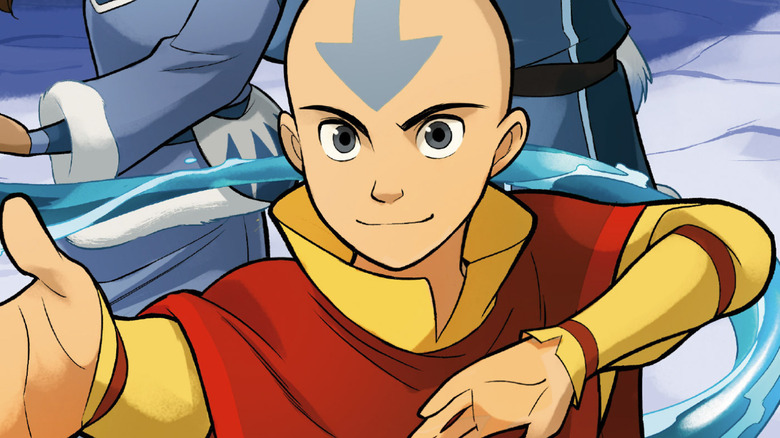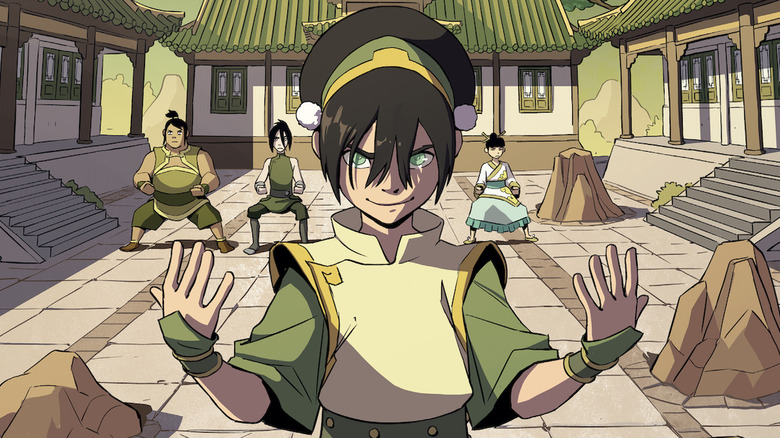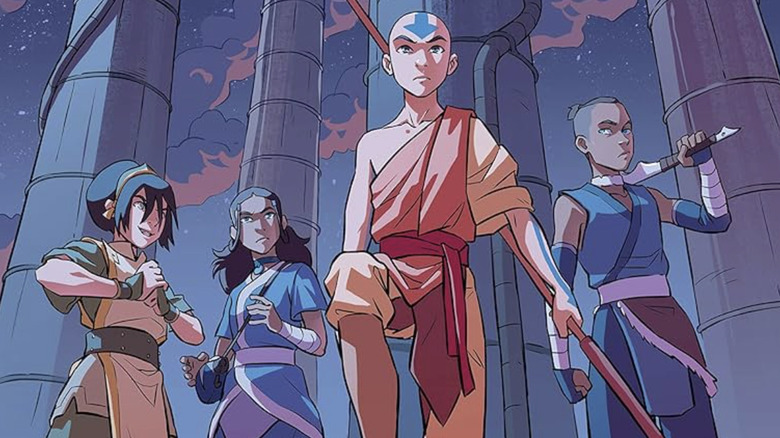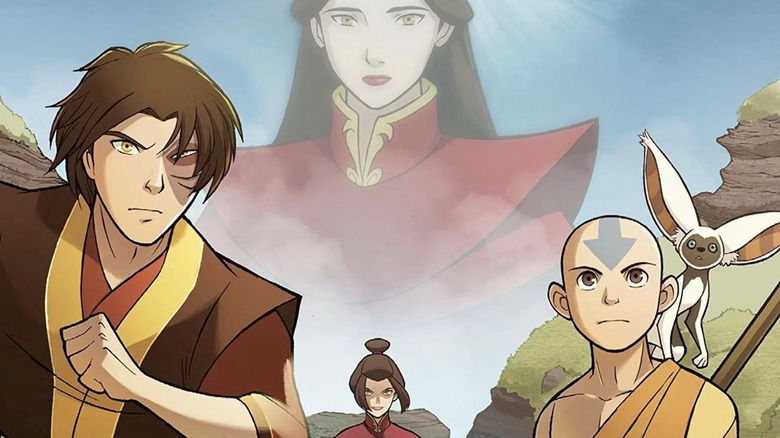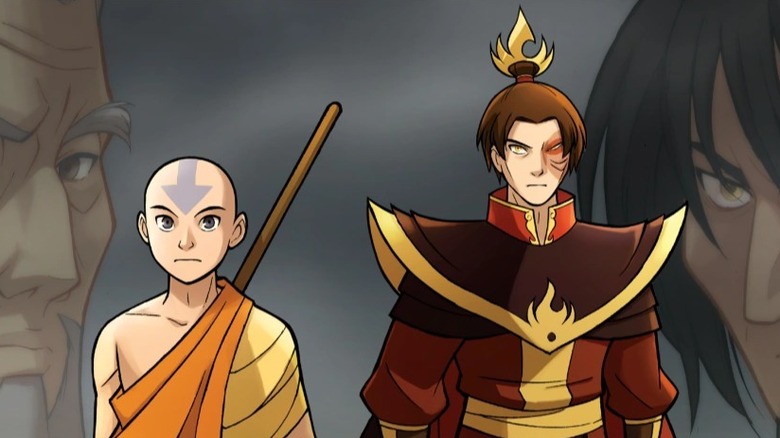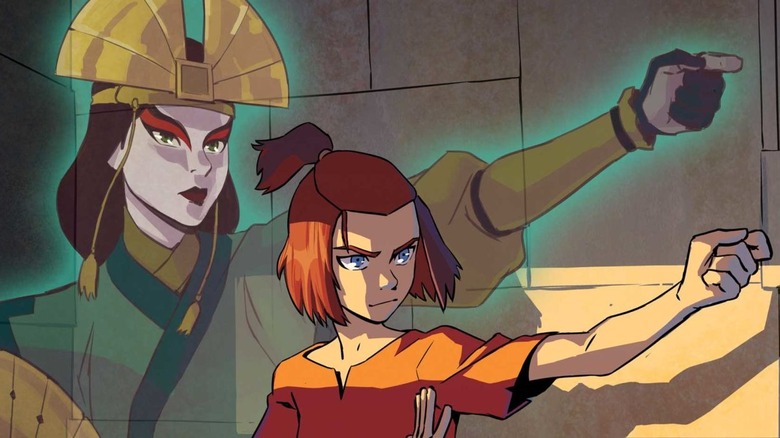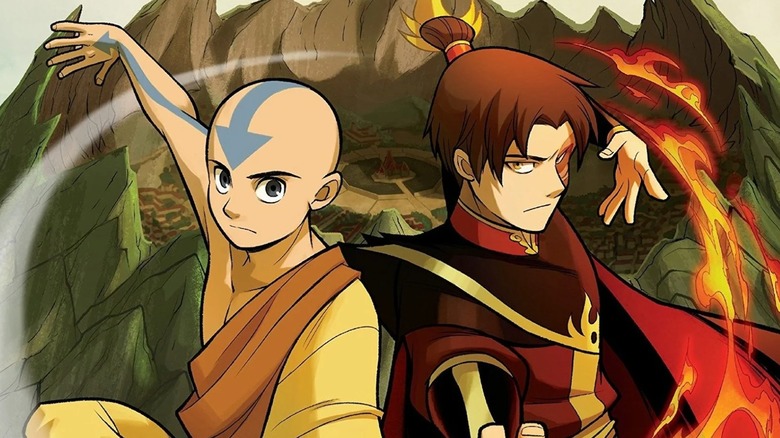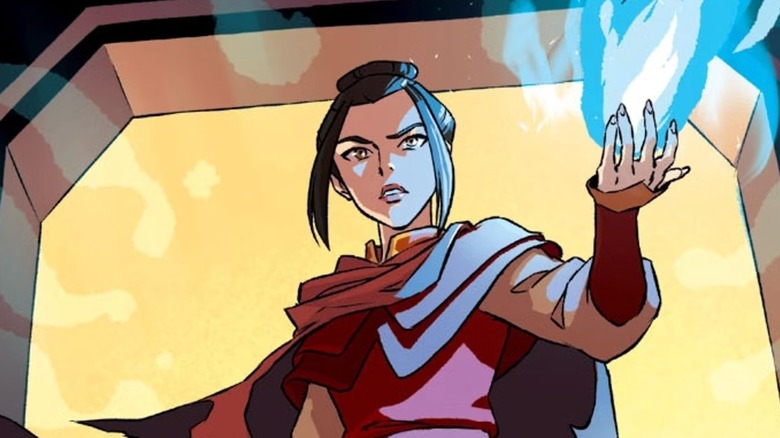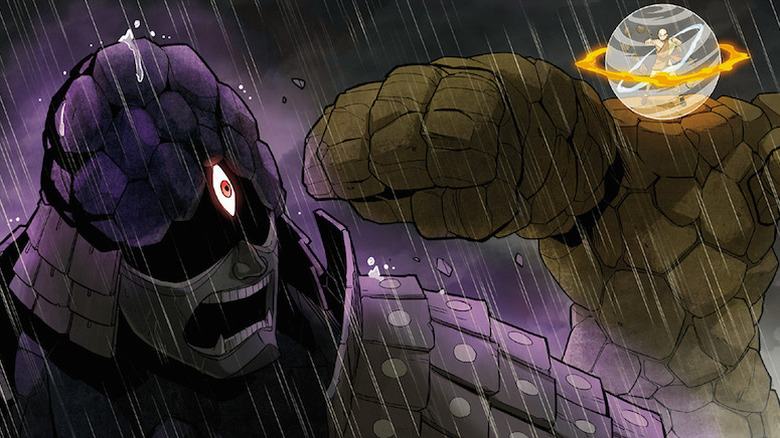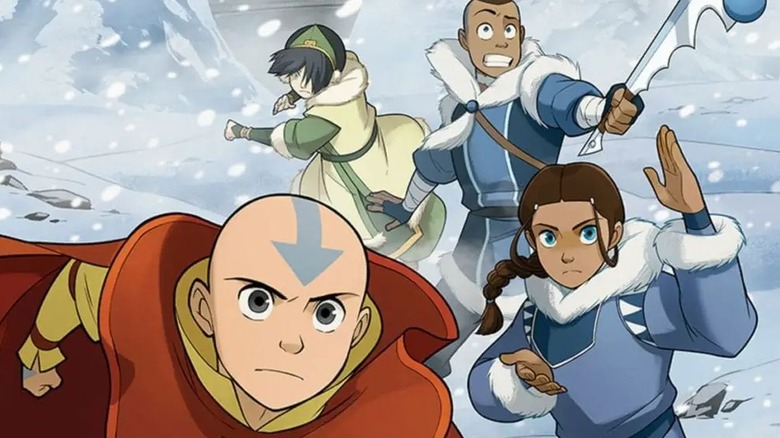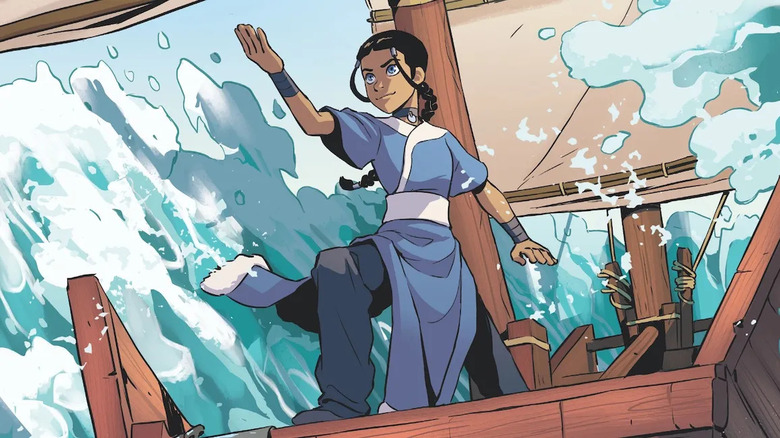Every Avatar: The Last Airbender Comic Ranked
"Avatar: The Last Airbender" told a complete and epic story across three seasons and 61 episodes, from 2005 to 2008. Now, it's been confirmed the Netflix-helmed live-action remake of "Avatar" will get to carry this story to the finish line once more.
The 2012-2014 sequel series "The Legend of Korra" showed what happened decades later, but there are other stories following the original Team Avatar after the series' wrap-up. And no, I don't mean the upcoming animated "Avatar" movie, releasing in 2025, that will follow these heroic kids as adults.
Since 2012, Dark Horse Comics has been publishing licensed "The Last Airbender" graphic novels, varying in length from trilogies to 80-page one-shots. The comics were first written by cartoonist Gene Luen Yang and drawn in the style of the animated series by artist duo Gurihiru (the same comic-creating team that went on to make "Superman Smashes The Klan"). Control has since been handed over to writer Faith Erin Hicks and artist Peter Wartman.
If you're an "Avatar" fan, here are the comics that should be on your radar, from worst to best.
10. Toph Beifong's Metalbending Academy
In "Avatar: The Last Airbender" season 2, Toph Beifong proved she is indeed the greatest Earthbender in the world by inventing a new type of bending: Metalbending, drawing on the earth impurities in metal to wield it as she does rock.
In the "Avatar" comics she establishes an academy to teach other Earthbenders her trade. This one-shot (by Hicks and Wartman) follows Toph as a teacher ... and how bored she's become. Toph joined Team Avatar because she wanted freedom and the chance to travel the world while being true to herself. Now with a home and no evil Fire Lord to defeat, Toph has settled into a routine that she finds stifling.
Unfortunately, that sense of stasis pervades into the comic itself; it's not bad, but it is inconsequential with little at stake. Beneath the routine, there are some good character moments for Toph at least. When she tries to crash an Earthbending fight club (like the one from her debut episode, "The Blind Bandit") and loosen up, everyone scatters because her reputation as an Avatar acolyte precedes her.
Toph, Sokka, and Suki also attend a concert for Trustfully in Love (the hippie band from the episode "The Cave of Two Lovers," who are now the Earth Kingdom's hottest sensation). Toph and the musicians discuss how doing something you love can feel burdensome when you do it as a job.
"Toph Beifong's Metalbending Academy" is a fun check-in with some old faces, but unfortunately it's little more than that.
9. Imbalance
"Imbalance" is the sixth "Last Airbender" comic trilogy, but the first created by Hicks and Wartman. The comic is a stylistic break from its predecessors; Wartman's line art isn't as sharp as Gurihiru's and he gives the characters smaller eyes/less exaggerated expressions (so less like anime characters), while colorist Ryan Hill's palette is earthier and has less of a sheen.
However, narratively, "Imbalance" follows on from the previous trilogies, particularly no. 3 "The Rift." Team Avatar (minus Zuko, who's busy being Fire Lord) returns to the industrializing port settlement Cranefish Town, which has grown from a village to a small city. The comic bridges to "The Legend of Korra" as well; Cranefish Town evolves into Republic City and industrialization is a major theme in the worldbuilding of "Korra."
The first villains in "The Legend Of Korra" are Amon and the Equalists, non-benders who believe they are subjugated and want to rid the world of bending. The villains of "Imbalance" are the opposite, Bending Supremacists who have taken note of how technology is leveling the playing field and aren't happy. The comic's social commentary isn't as progressive as it thinks it is (the catalyst for the villains is a labor dispute, where they're fired by a factory owner because machines can do a bender's job for free — the pro-capitalism themes are inherited from "Korra" as well), but within the text, the villains feel both new and like a natural outgrowth of the setting.
8. The Search
The biggest lingering mystery of "Avatar: The Last Airbender" was what happened to Zuko and Azula's mom, Ursa. She disappeared when they were young, banished by their father/her husband Ozai after she assassinated Fire Lord Azulon to save Zuko. A reunion between Zuko and Ursa was cut from "Sozin's Comet," so fans were left wondering for five years until 2013 when the second comic trilogy, "The Search," was released.
The result shows why some mysteries are best left to the imagination. The comic interweaves Zuko, Azula, and friends searching for Ursa with flashbacks showing Ursa's life from her early marriage to her disappearance. The show, being aimed at children, had to keep the political machinations and violence of the Fire Nation palace vague. Honestly, I think that was to its benefit since viewers could fill in those gaps themselves. Some of the answers that Yang sets in stone make Ozai and Ursa less interesting. Showing the challenge of a shift in medium, Azula's insanity just doesn't hit the same without Grey DeLisle's voice acting.
A highlight of the comic is the Spirit World's presence, which feels as alien as it did during the scariest moments of "Last Airbender." Gurihuru's design for the Mother of Faces, echoing the multi-head look of Hindu God Shiva, is right at home in the Asian-inspired world of "Avatar."
7. The Promise
The first "Avatar" comic trilogy, "The Promise" picks up right after the series finale, "Sozin's Comet," and shows Team Avatar on a bumpy ride entering the new world they've built. Toph builds her Metalbending academy while Aang meets "Airbending Acolytes," an Avatar fan club who revere his extinct culture. He goes from honored to angered when he finds they're unknowingly distorting some traditions.
The main conflict, though, rests with Zuko; he's as torn as ever, now between his friendship with Aang and his duty as Fire Lord. This is where the comics wrestle with thornier topics than the show ever attempted — namely, decolonization. Since "The Last Airbender" was about ending imperialism, "The Promise" chronicles the managing of its aftermath.
Long story short, the Fire Nation has many colonies in the western Earth Kingdom. Zuko initially promises the Earth King that he'll remove them and send his citizens back to the Fire Nation. Then, he learns it's not that simple; the Fire Nation colonists have been intermarrying with the Earth Kingdom natives, melding their blood, cultures, and technologies. Some Earthbenders even have Fire Nation ancestry/citizenship and don't want their families torn apart.
So, Zuko decides he must stand behind his people and risk reigniting the 100-Year War. "The Promise" concludes that after a century of war, trying to put things back to how they were before is impossible. The heroes need to build a new world entirely from the mess they've been handed.
Putting Zuko in an antagonistic role again does feel tiresome after a series of following his journey to becoming Aang's friend. But that's Yang and the comic's point: clean endings rarely stay clean for long.
6. Suki Alone
"Avatar: The Last Airbender" left Suki in limbo for some time. In season 2, she's last seen fighting Azula in "Appa's Lost Days" and when the latter returns, she's wearing Suki's stolen Kyoshi Warrior outfit (modeled on the eponymous Avatar). Suki only returns about 20 episodes later in season 3's "The Boiling Rock." It turns out she's been held in prison and escapes with Sokka and Zuko.
"Suki Alone" chronicles her previously unseen months at the Boiling Rock. The title scheme echoes two acclaimed episodes, "Zuko Alone" and "Korra Alone," and likewise focuses on a single character working through their struggles in isolation. Suki tries to keep her strength and hope up, relying on her warrior training and memory of Kyoshi after her fellow prisoners prove unreliable. Also included are some flashbacks to her early childhood.
By its design as a gap-filler, "Suki Alone" can't help but feel limited (the final panel is Sokka and Zuko arriving, directly leading into "The Boiling Rock"). Still, it avoids being superfluous by giving Suki some backstory and personal challenges that the show itself never had room for.
5. Smoke and Shadow
The fourth Yang/Gurihiru trilogy, "Smoke and Shadow" feels like a sequel to "The Search." Ursa makes her first return to the Fire Nation capital and must confront her lingering fear of Ozai (even if he's now powerless and imprisoned). Meanwhile, Zuko's reign as Fire Lord is tested from within by political dissidents and cloaked spirits called the Kemurikage (their creepy designs are one of Gurihiru's best). Under these pressures, Zuko grows more paranoid and authoritarian.
I appreciate how Yang handles Zuko's turmoil. Yes, he's a good guy now (the comic ends with him publicly acknowledging his mistakes and promising his citizens he will continue striving to be the leader they deserve). But still, his change of heart didn't melt away his flaws. Now that he has the responsibility of being Fire Lord, the qualities he inherited from his father risk seizing control.
In "The Promise," Zuko seeks Ozai's counsel because only his father understands the burden of nation-defining decisions. In "The Search," Zuko learns he may not be Ozai's son and is torn between his wish to dissociate from the man and the duty to lead his people (it turns out to be a red herring). In "Smoke and Shadow," Zuko must stop his fist from hardening into iron like Ozai's.
If I can make a comparison, it's like how Rian Johnson wrote Luke Skywalker— not, but as "a video game character who has achieved a binary, permanent power-up," but a fallible human who never quite overcomes the flaws that make him, him.
4. Azula in the Spirit Temple
The fourth one-shot from Hicks and Wartman, "Azula in the Spirit Temple" follows the former Fire Nation Princess making a journey inward. Since "The Last Airbender" ended, fans have argued back and forth about whether Azula could have a redemption arc like her brother did or if she even deserves one (to quote Bill Munny in "Unforgiven," "Deserves got nothing to do with it").
For what it's worth, series head writer Aaron Ehasz said he "always intended" Azula to turn over a new leaf, with Zuko supporting her as Uncle Iroh did for him. Hicks and Wartman play it vaguer.
Azula has gathered new followers and is leading attacks to disrupt Zuko's reign, but she hasn't learned her lesson about mistreating minions from when Mai and Ty Lee betrayed her. While tracking the deserters, Azula stumbles on a spirit who helps those in need; the question becomes if she'll take the offered hand.
"Azula in the Spirit Temple" is the best looking of the Hicks' written one-shots (colorist Adele Matera amps up early contrasts between Azula's red outfit and rainy background blues, making the mood feel all the gloomier). Like the other one-shots, the conclusions feel like baby steps for the title character's development, but it works ok because Hicks is more focused on how Azula's past made her who she is; there's only a glimmer of suggestion about what she might become.
3. The Rift
Reading his additions to "Avatar," it's clear that Yang loves Zuko and the Fire Nation characters the most — three of his trilogies focus on them. Zuko is my favorite too, so I'm a bit surprised that I think Yang's best "Avatar" comics are the ones that move away from the Fire Nation.
"The Rift" follows Team Avatar's first visit to Cranefish Town (built on the site of a sacred Air Nomad tradition) and the introduction to modern technology (Sokka takes a liking to forklifts). The comic focuses mostly on Toph and Aang, while the title carries a double meaning. For one, Toph discovers her disowned father (who refuses to accept that her blindness doesn't make her weak) is one of the factory's owners. Second, Aang must discover why a spirit, General Old Iron, is planning to attack Cranefish Town; it goes back to a promise between the Spirit and the previous Air Nomad Avatar, Yangchen, that later generations forgot. Iron's design continues the strong spirit artwork from "The Search," while his battle with Aang and the story's environmental themes evoke "Princess Mononoke."
"The Rift" may be named for a great divide, but it's one of the most cohesively made "Avatar" comics.
2. North and South
Yang and Gurihiru's final "Avatar: The Last Airbender" comic is also their best. "North and South" follows Katara and Sokka returning home to the Southern Water Tribe and it's changed a lot in the year or so they've been gone. Thanks to visitors from the Northern Water Tribe, their village has gone from a circle of igloos to a full-fledged town (with buildings made from ice). However, some of the Southerners are wary of how modernization will bury their traditions and turn their Tribe into a simple client state of the North. They turn to terrorism while Katara and Sokka wrestle with their own conflicted feelings.
"North and South" again relies on the same themes that Yang has been exploring — an evolving world and people caught in its wake, cultures coming together to create something new, etc. — and brings them to the Water Tribes. The comic explores the other side of cultural integration; how much identity should a nation forfeit in the name of progress?
As this is Yang's last "Avatar" comic, it feels like a bow being tied up. The ending of "North and South" is Yang's thesis statement. The main characters all sit down for a meal, composed of dishes from each of the four nations. The page is arranged in a box-shaped collection of four panels: close-ups of (in clockwise order) Aang, Katara, Zuko, and Toph each sharing their culture's food. The comic ends with a single-panel page of the characters sitting in a circle and enjoying this fine meal. What was once separate is now brought together into a harmonious whole, where differences are acknowledged but no longer act as barriers.
1. Katara and the Pirate's Silver
Yes, the best "Avatar: The Last Airbender" comic is also the most modest: Hicks and Wartman's one-shot "Katara and the Pirate's Silver." Unlike the others on this list, this one is set during the show (specifically in season 2, between "Bitter Work" and "The Library"). Rather than this hindering the comic, it works to its benefit. "Katara and the Pirate's Silver" is a story that could easily fit in as a real episode of the show.
The story: while Team Avatar is flying through the Earth Kingdom on Appa, they have to dodge some Fire Nation catapult attacks and Katara falls out (landing softly due to her Waterbending and a nearby river). The rest of the team searches for her, but only after comically failing to deprogram a fanatical Fire Nation soldier.
Katara, lost in enemy territory, joins up with a gang of pirates led by a woman named Jiang; since they sail on the seas, the pirates find easy use for her Waterbending. Everything about the comic feels in tune with the show, from the humor to the reveal that the pirates aren't actually bad (they were transporting stolen medicine to impoverished Earth Kingdom citizens, taking only rare silver flowers as payment). Katara, who's all about helping people, also feels right at home as the star; the story is akin to her starring episodes like "Imprisoned" and "The Painted Lady."
Of all the "Avatar: The Last Airbender" comics, the one that most recaptures the sense of watching the animated series is "Katara and the Pirate's Silver."
